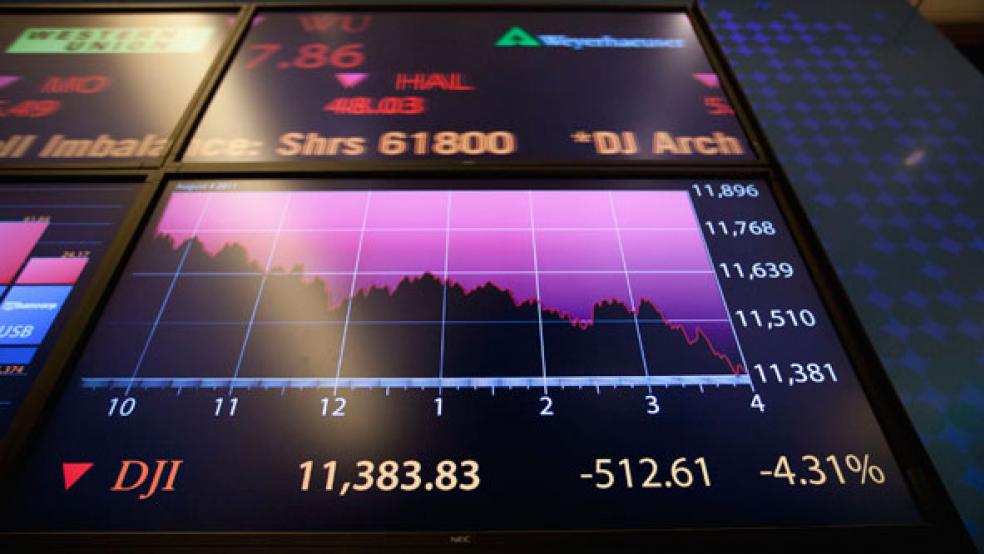Fed policymakers couldn’t have made it any plainer: Interest rates will be staying low until at least the middle of 2013. And as the stock market swooned today — with the Dow down as much as 500 points in morning trading -- yields on 10-year Treasury notes dipped to near-record levels as global investors sought refuge from the storm of downbeat economic news.
So what’s a yield-starved investor to do?
Curiously, one of the most obvious solutions – buying blue-chip stocks that pay hefty dividends – hasn’t gained much momentum despite a seemingly constant stream of suggestions from investment advisors and market pundits that it’s the perfect strategy for the current environment.
“This is a great pond to fish in for investors looking for a way to replace the yield they’ve been losing for years in the Treasury market,” says Bill Stone, chief investment strategist at PNC Asset Management Group. “But if people agreed with all of us who are pointing it out, it would show up in the data, and that isn’t happening yet.”
In fact, Stone notes, the 100 stocks that make up the Dow Jones U.S. Select Dividend Index are selling more cheaply—with lower price-earnings and price-book ratios— than those in the Standard & Poor’s 500-stock index. Stocks in the Dow Jones Dividend Index yield 4.11% annually, compared with 2.14% for those in the S&P 500, but have a price-earnings ratio based on past profits of 12.93, vs. 13.12 for the S&P 500. While investors crave income, they paradoxically seem to be shunning stocks that pay out dividends.
Scott Schermerhorn, chief investment officer of Granite Investment Advisors in Concord, N.H., has found another way in which investors are behaving strangely. Comparing the yields offered by stocks of top-rated companies like Johnson & Johnson and Abbott Laboratories with those on bonds issued by the same companies maturing in three to five years, he has found bond yields are routinely lower than those on stocks in the same companies. “I’ve never seen that kind of pattern before, and it doesn’t make sense,” says Schermerhorn. “Yields on dividend stocks should be lower than bonds because in theory you are giving up a bit of yield in order to get exposure to growth in the stock price. But that logic has just gone out the window.”
In fact, the appeal of dividend-yielding stocks is that they combine income with the prospect of growth, which other income-generating securities – bonds – can’t offer. Buy a Johnson & Johnson bond, and you’ll get back your principal. Yes, investing in the stock of a triple-A rated company like Johnson & Johnson, with $27 billion of cash in its coffers, may offer a more volatile ride on a day-to-day basis than buying its bonds. But leaving aside the tumultuous market movements, companies that continue to grow revenues and earnings should fare well over a period of months to years. True, bonds do rank higher in the capital structure, meaning bondholders are much more likely to see their money again if the company falters, but veteran investors like Schermerhorn agree that probably shouldn’t be so great a consideration that it causes people to walk away from an extra percentage point or two of yield in the current environment.
The only explanation that Schermerhorn and others can come up with is that investors are so fearful of stocks as an asset class, in the wake of events like the 2008 financial crisis, last year’s “flash crash” and this summer’s panic-driven selloff, that they’d rather be underpaid than feel even slightly vulnerable. That opens up a tremendous window of opportunity for more clear-headed investors who are willing to look past the current turmoil and focus instead on fundamental issues, like valuation and yield.
Those investors, says Mark Luschini, the Pittsburgh-based chief investment strategist at Janney Montgomery Scott, are likely to see the array of appealing dividend-yielding stocks grow as pressure mounts on cash-rich companies to stop hoarding their money. Networking giant Cisco Systems began paying dividends this year, for instance. Companies that already offer dividends likely will keep raising those payout ratios, he argues.
That’s not the only appeal of the large, blue-chip companies that tend to lead most lists of businesses rewarding their investors with yield, Luschini says. “If you look at those lists, you’ll see that these are high-quality franchises and multinational businesses, so investors also can tap into growth internationally, including in emerging markets.” The dividends are the icing on the cake, he says. “At least while you wait for a more rational and stable market environment, you’ll be generating income.”
True, not all dividend-paying stocks are created equal. Utilities may offer rich dividends, but don’t often generate much growth; they’re also highly regulated businesses. And not every dividend is “safe”: If a company is forking out the bulk of its cash flow in the form of a dividend, it will eventually have to cut that payout. A company that generates a disproportionately high dividend yield may be a sign of trouble rather than largesse, as the yield rises whenever stock prices fall; again, that yield probably won’t stay high for long. One quick way to gauge the safety of a company’s dividend is to compare its annual payout with its annual earnings per share. The greater the gap is between the two (with the earnings outstripping the dividend, obviously), the more likely the company is to not only continue paying that dividend but also perhaps even boost it.
“Investing in dividend stocks isn’t automatically or always the best way to own stocks, but there are times when it really comes into its own, when income is greatly valued and the stock prices don’t yet reflect that value,” says PNC’s Stone. “This is one bandwagon that still has room for more people to climb aboard.”





